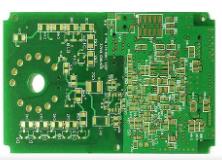The names of the circuit boards are: ceramic circuit boards, alumina ceramic circuit boards, aluminum nitride ceramic circuit boards, circuit boards, PCB boards, aluminum substrates, high frequency boards, thick copper boards, impedance boards, PCBs, ultra-thin circuit boards, ultra Thin circuit boards, printed (copper etching technology) circuit boards, etc.
Classification
According to the number of layers, circuit boards are divided into three major categories: single-sided, double-sided, and multi-layer circuit boards.
Circuit boards are divided into FPC, rigid boards (PCB), and rigid-flex boards (FPCB) according to their characteristics.
Circuit board sheet
FR-1: "flame retardant copper clad phenolic paper laminate. IPC4101 detailed specification number 02; Tg N/A;
FR-4: 1) Flame-retardant copper-clad epoxy E glass fiber cloth laminate and its bonding sheet material. IPC4101 detailed specification number 21; Tg≥100 degree Celsius;
2) Flame-retardant copper-clad modified or unmodified epoxy E glass fiber cloth laminate and its bonding sheet material. IPC4101 detailed specification number 24; Tg 150 degree Celsius~200 degree Celsius;
3) Flame-retardant copper clad epoxy/PPO glass cloth laminate and its bonding sheet material. IPC4101 detailed specification number 25; Tg 150 degree Celsius~200 degree Celsius;

4) Flame-retardant copper-clad modified or unmodified epoxy glass cloth laminate and its bonding sheet material. IPC4101 detailed specification number 26; Tg 170 degree Celsius~220 degree Celsius;
5) Flame-retardant copper-clad epoxy E glass cloth laminate (used for catalytic addition method). IPC4101 detailed specification number 82; Tg N/A;
Test Methods
Needle bed method
In this method, a probe with a spring is connected to each detection point on the circuit board. The spring makes each probe have a pressure of 100-200g to ensure good contact between each detection point. Such probes are arranged together and are called a "bed of needles".
Observation
The circuit board is small in size and complex in structure, so the observation of the circuit board must also use professional observation instruments. Generally, we use a portable video microscope to observe the structure of the circuit board. Through the video microscope camera, we can clearly see the very intuitive microstructure of the circuit board from the microscope. In this way, it is easier for us to design and test the circuit board.
Flying probe test
The flying probe tester does not rely on the pin pattern installed on the fixture or bracket. Based on this system, two or more probes are mounted on a tiny magnetic head that can move freely on the x-y plane, and the test points are directly controlled by CADI Gerber data. The dual probes can move within a distance of 4 mils from each other. The probes can move independently, and there is no real limit to how close they are to each other. The tester with two arms that can move back and forth is based on the measurement of capacitance. The circuit board is pressed tightly and placed on the insulating layer on a metal plate as the other metal plate of the capacitor. If there is a short circuit between the lines, the capacitance will be larger than at a certain point. If there is an open circuit, the capacitance will become smaller.
The following three levels of testing are usually carried out:
1)Bare board inspection;
2) Online testing;
3) Functional testing.
Circuit board inspection is the process of finding, determining and correcting the failure of each electronic component on the circuit board. In fact, the entire inspection process is a thinking process and a test process that provides logical reasoning clues. Therefore, the inspection engineer must gradually accumulate experience and continuously improve the level in the process of circuit board maintenance, testing, and repair. General electronic equipment is composed of thousands of components. During maintenance and overhaul, it will be very time-consuming and very time-consuming to find problems by directly testing and inspecting each component in the circuit board. difficulty. Then the check-in type inspection method from the fault phenomenon to the cause of the fault is an important method of inspection and repair. As long as the circuit board detects the problem, it is easy to repair. The above is an introduction to the basic knowledge of circuit board maintenance.